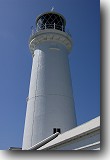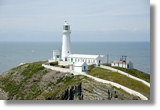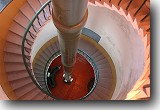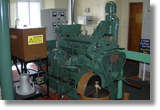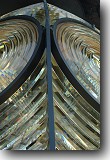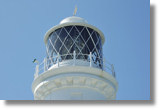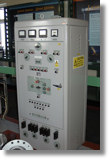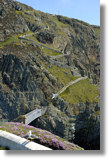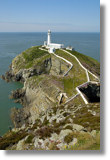South Stack lighthouse
Anglesey is an island decorated with dramatic cliffs, isolated coves and sandy beaches. These overlook the Irish sea with its busy shipping lanes and its rocks pose a threat to the vessels sailing by. As a result the coastline is dotted with lighthouses. The most famous and picturesque of these is South Stack, near Holyhead.
The South Stack lighthouse is one of the iconic images of Anglesey, often appearing on brochures and web sites promoting the island. It is a popular visitor attraction, not only for the views of the coast and visits to the lighthouse itself, but also for the surrounding nature reserve, run by the RSPB, with thousands of seabirds nesting on the cliffs in the spring.
You can find South Stack with this map or an aerial image on Google Maps. A real-time map showing the larger ships sailing in the Irish Sea past Anglesey can be seen at the ShipAIS site.
Are you looking for images of South Stack for your web site or publication? The photos on this page, as well as many others by the author, Warren Kovach, are available for purchase from Alamy.
The South Stack lighthouse is built on Ynys Lawd, a small rocky island just off the edge of Holy Island, which itself is an island just barely separate from the main part of Anglesey. To reach it you need to descend a switchback stairway running down the cliff face, over 400 steps down (and 400 back up). At the bottom a bridge carries the visitor over a chasm to the island. Once there, you can explore the tiny island, view the exhibition about the history of the lighthouse, and climb more steps in a guided tour to the top of the 28m tall lighthouse tower.
Planning and Construction
The Irish Sea around Anglesey has been a busy shipping area for centuries, not only with traffic between Wales and Ireland but also shipping into Chester and, after the River Dee leading to Chester silted up, Liverpool. The often stormy seas and the rocky coasts meant that many ships and lives and much cargo was lost.
The need for a lighthouse on this part of the Anglesey coast was recognized as far back as 1665 when a petition was sent to King Charles II asking for a lighthouse to be built on South Stack. This request was refused, however, as being an unjustified expense for ship owners.
Increased traffic after the Act of Union between Britain and Ireland in 1800 fuelled demand for better navigational aids in the area. Captain Hugh Evans, an experienced mariner who frequented the waters around Anglesey, began researching shipwrecks in the area and in 1807 produced a map of Holy Island showing all the wrecks in the previous two years. With this he began a campaign to build a lighthouse on this coast, approaching ship owners and masters as well as merchants in Liverpool to support the cause.
Their case to build a lighthouse was presented to the Board of Trinity House, the lighthouse authority for Britain, but it again was rejected on cost basis. Captain Evans, an apparently dogged campaigner, went back to his supporters and returned with promises to double the amount they would pay in light dues to support the lighthouse. The resubmission of the plans was successful and in 1808 planning of the lighthouse began.
Construction began in August 1808, following plans drawn up by the surveyor and architect Daniel Alexander, and was overseen by Captain Evans. It was completed nine months later, an amazing feat given the difficulties of building a tower on a rock below steep cliffs, surrounded by rough seas. Much of the building stone was quarried on Ynys Lawd itself, but limestone from Penmon quarry, in the eastern corner of Anglesey, was brought in for the circular staircase, as was slate for the flooring and window sills.
These plus other materials were mainly winched up from boats in a small sheltered cove, although other materials and daily provisions were drawn across in baskets on a aerial ropeway extending to the mainland. This was eventually upgraded to a stronger system with box cradles that allowed the workers to be carried over as well. This continued to be used by the keepers for five years after construction was finished, but was eventually replaced by a rope suspension bridge. In 1827 Captain Evans, being inspired by the recent opening of the Menai Bridge, oversaw the construction of a iron suspension bridge across the gorge, which was much more stable.
Additional Signals
The original lighthouse produced its light by 21 oil lamps backed by reflectors 54cm in diameter. These were on a three sided rotating base, each side with seven lamps, powered by clockwork. It took six minutes for one rotation, so the lighthouse gave a flash from one of its three sides every two minutes. This light, shone from 60m above the sea level, could be seen up to 30 miles away in the best weather conditions.
However, conditions were rarely ideal. When it was foggy or the cloud base low the tall light would be useless. In 1831 Captain Evans came up with the unique idea of a moveable low light that would shine out closer to the sea surface. A track was constructed on a steep incline down the cliff on the north side of the island (the left side on the adjacent photo). Onto this was set a wheeled wooden cabin containing oil lamps shining out windows in the seaward side. This could be lowered to within 12m of the sea. This increased visibility of the light and improved safety greatly for ships near the coast. Captain Evans won wide praise for his ingenuity in designing the system and a commendation from the Trinity House Board. It worked admirably for several decades until it was replaced by a stationary low light at the western tip of the island in 1880 (within the circle at the front of the adjacent photo). This operated until 1907, when it was removed after the main light had been upgraded (see below).
Fog signals
Even this light would be of little use in very foggy conditions, so eventually plans were made for a auditory signal, a fog bell. This two-ton bell, installed in 1854, was one of the largest bells in the United Kingdom. It was struck by a clockwork mechanism and was installed on the western tip of the island. After installation the bell proved to be unreliable as a result of salt spray affecting the machinery. A shed was built around it to protect it, but further problems in the design meant that the clockwork needed winding far more often than thought, and would not work at all in poor, windy conditions.
These were eventually solved with a redesign and refit, and the bell worked reliably afterwards. However, it still proved problematic as the distance it could be heard from depended on the direction and strength of the wind. A fog canon was installed further up the coast at North Stack to help out, but eventually the bell was replaced in 1895 by a fog siren. This was a reed horn fog signal powered by two oil engines and could be heard much further, although there were still complaints that it couldn't be heard from some ships.
At around this time a new system of fog signalling was being developed that relied on the fact that sound travelled further through water than air. Sound systems were developed that could be installed underwater near rocks and shores. Ships would then install hydrophones, two listening devices placed on either side of the ship. When listened to through headphones a trained operator could detect the direction of the signal and determine their position. In 1909 an underwater bell was installed on the seabed north of South Stack, with an electrical cable running out from the lighthouse to power the mechanism. This too initially proved unreliable and had to be sent back for reengineering, and afterwards needed frequent maintenance. It was eventually removed and scrapped in 1926.
In 1936 work began on replacing the reed fog horn with a two-toned diaphone system. This was powered with compressed air produced by a diesel engine and was put into operation in 1938. This was replaced with an electrically powered fog horn in the 1960s when mains electricity was brought to the island. An automatic fog detection system was also installed.
Telegraph
In busy shipping lanes it was desirable to not only warn ships of hazards but also to provide some means of communication with the mainland. As early as 1801 an optical telegraph station was established (again by Captain Evans) on Holyhead Mountain, just a short distance inland from South Stack. By means of semaphore flags ships could send messages to North Stack, which were relayed down to Holyhead Port. Eventually these were passed on to the Liverpool - Holyhead Semaphore Telegraph after its establishment in 1827, thus allowing the port authorities to prepare for incoming ships.
Following the development of electrical telegraph technology the Mersey Docks and Harbour Board began setting up telegraph stations along the North Wales coast. The station at South Stack was established in a disused keepers cottage in 1861, where operators could look out for semaphore signals from ships and relay them back to Liverpool electrically. The wires ran from here to Point Lynas station and lighthouse, on the north coast of Anglesey, where they ran undersea to the Great Orme and from there further up the coast and under the sea to Liverpool.
During the First World War there were concerns that German boats would be able to intercept semaphore messages and use them against the ships, so the telegraph stations were closed down. After the war most of the other stations reopened but (again to cut costs) the South Stack station remained closed and the building was eventually demolished.
The New Lighting Apparatus
Technology moved on following the construction of South Stack lighthouse and in 1869 planning was begun to improve the lighting apparatus. The following year additional lamps and reflectors were added to the existing system, which resulted in a much brighter light. However the best way to improve the light would be to completely replace it with a new system.
In 1873 Chance Brothers glass makers, from Smethwick, Birmingham, were invited to submit a proposal. They had produced systems to other lighthouses run by Trinity House, as well as others around the world. Their systems were based on Fresnel lenses, a series of lenses and prisms that worked together to concentrate the magnified light into a beam that could be directed out to sea, thus improving its visibility.
In this new system the lamp was stationary in the centre of the apparatus and the lenses rotated around it. The lens system was six sided, producing six separate beams of light. It rotated on a bed of roller bearings, completing a revolution in six minutes, so that a flash of light was produced every minute. The use of Fresnel lenses meant that around 80% of the light produced by the multiwick paraffin lamp was directed out to sea.
At the same time the windows of the lantern room at the top of the lighthouse were also replaced. The lantern originally had square windows, but the horizontal and vertical bars between the windows blocked a substantial amount of light, particularly from certain angles. The new windows were diamond shaped, with diagonal cast iron bars between, which allowed the light to shine fully at all angles.
In 1905 further innovations in lighting technology allowed for the installation of a new, much brighter lamp. This was a incandescent mantle burner lamp, which was supplied by pressurised paraffin tanks. Shortly after this the rotation mechanism was also improved. The roller bearings were replaced by a trough of mercury. Mercury is so dense that even the heavy lens apparatus would float on it, but with less friction and greater ease than the bearings. As a result the rotation of the mechanism was increased to one revolution every minute, thus giving a flash of light every 10 seconds.
In 1938 the lamp was again replaced with an electric lamp, powered by a diesel generator. This new lamp was rated at 2 million candle power, almost eight times as bright as the previous lamp. In the 1960s mains electricity was brought to the island, not only to provide a constant supply for the lighthouse lamp, but also to provide electricity for the keeper's dwelling, something they had lacked up to now.
The original electrical lamps were large 1000 watt lamps. A number of old ones are on display at the lighthouse. However, in 1999 the lighthouse was modernized and the lamp was replaced with a much smaller and longer life 150 watt metal halide bulb. This reduction in size reduced the distance the light could be seen from 25 to 20 miles.
The Keepers
Lighthouses, particularly early ones with oil lamps, required a high degree of maintenance. The keeper and his assistant would need to keep the lamps fuelled, the mirrors polished and the windows clean, as well as start the fog horn when required, along with general upkeep of the buildings. The keeper and the assistant worked in shifts, and when on duty they would stay in the room just below the lamp room at the top of the tower. The island had enough room for dwellings to be built so that the keeper's families could stay there with them. Many children were born and raised on Ynys Lawd.
The first keeper was James Deans, and his assistant was Hugh Griffiths. Unfortunately Deans and Captain Evans did not get along and regularly argued, so much so that Captain Evans eventually recommended to Trinity House that Deans be dismissed. Griffiths took over as head keeper on Captain Evans' recommendation. His new assistant, Thomas le Cheminant, was also eventually dismissed for neglect of duty and insubordination.
The next assistant was John Jones, who was a diligent worker, and he and Griffiths worked together for 18 years until Jones' early death in 1828. On his death Captain Evans took the unusual step of recommending his widow, Ann Jones, as the next keeper. As she had lived at the lighthouse for 15 years she knew how to carry out all the tasks. In the mid 1840s she was followed in the post by her son, Jack Jones, who had been born on the island and grew up there. He was tragically killed during the great storm on 25 October 1859, in which the famous Royal Charter sank off the north coast of Anglesey, by rocks falling from the cliff face as he returned down the stairs to the lighthouse.
Hugh Griffiths retired in 1853 at the age of 78 and was replaced by Henry Bowen, son of a lighthouse keeper and himself an experienced keeper, having previously been assistant keeper at Smalls lighthouse near St. David's, Pembrokeshire. During his time he oversaw installation of the first fog bell as well as the reconstruction of the keepers accommodation and storerooms. After ten years he was moved to the lighthouse at Penmon where he remained until his death in 1878.
A number of other keepers and their families followed, but in the 1930s concerns were raised about the safety of young children living on the island. In 1935 the designation of the lighthouse was changed from "isolated shore station" to "rock station", which meant that only the keepers could stay there. They needed to find accommodation on-shore for themselves and their families. From then on they worked on a shift system, one month on South Stack and one month off.
During the 1980s Trinity House began a program of automating all their lighthouses. Equipment would be installed at the lighthouse to monitor operation remotely and the lighthouses would only be visited occasionally for cleaning and maintenance. South Stack switched to automated operation on 13 September 1984. Its last keepers were Stanley Booth and Norman Grindle, along with their assistants Dermot Cronin and Peter Halil.
For more about life as a lighthouse keeper see this BBC interview with Bill O'Brien, one of the last South Stack lighthouse keepers.
Today
As can be seen above, South Stack has gone through many changes over the years. With the automating of the light many of the buildings around the island became redundant. However, they are also listed as historic buildings, so couldn't be demolished and needed to be maintained. To provide funds for this it was decided to open the island and lighthouse to the public as a paying attraction.
Before this could be done the bridge to the island needed to be replaced. Captain Evans' original suspension bridge had been replaced in the 1960s by an aluminium truss bridge. However, this was by now in poor repair. A new, stronger truss bridge was built in 1996. The frame of the new bridge was built around the old one, which was then dismantled from within.
On 9 August 1997 the new visitor attraction was officially opened. After descending the steps visitors can view a variety of exhibits about the history of the lighthouse, take a guided tour to the top of the tower, and explore the island. Friendly staff are on hand to answer questions about the island.
After the long climb back up the stairs refreshment is on hand in the form of the usually present ice cream van, or the cafe further down the road. Also in the area is Elin's Tower, the RSPB's visitor's centre for their reserve, where you can learn more about the birds nesting on the cliffs and throughout the area. Ancient history can be explored with a visit to the Ty Mawr Hut Circles, the remains of an Iron Age settlement last occupied during the Roman era. Finally a short climb to the top of nearby Holyhead Mountain provides a sensational view of Holyhead harbour, Holy Island and beyond.
Acknowledgements
I am grateful to Ian Jones, the author of South Stack: Anglesey's Famous Lighthouse (2009), an excellent historical account of the lighthouse, from which many of the above facts are drawn. It is published by the Isle of Anglesey County Council and is available from Amazon or the shop at Oriel Môn.
A new book by Warren Kovach, author of this web site


